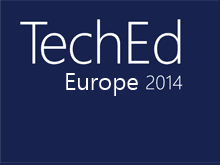This week I am to TechEd 2014 at Barcelona. For this days, I have chosen the below session:
- TechEd Keynote
- Optimizing your Datacenter with Windows Server, System Center, and Microsoft Azure
- Software Defined Compute in the Next Release of Windows Server Hyper-V
- Next Generation Networking in the next release of Windows Server: SDN, NFV and Cloud Scale fundamentals
- Software Defined Storage in the next release of Windows Server
First a presentation of the last build of Windows 10 has been done:
- The (re)new start menu;
- The titles in the start menu;
- The virtual desktop;
- The Windows interface switching depending of using a keyboard or not on a Surface Pro 3. . If the keyboard is used, the windows user interface is in desktop mode and if you use the Surface Pro 3 without keyboard Windows switch on tablet interface;
- Logon with your Windows Phone instead of using password;
- You can choose if the computer is bought for personal use or for organizational use. In case of organizational use, the user can enter some credentials and the computer is enrolled in the IT of the organization;
Next new features has been teased regarding Azure Pack and Microsoft Azure:
- “G” Virtual Machine (32CPU, 448GB RAM and 6,5TB SSD);
- Docker Engine that enables to run Linux commands from Windows;
- Azure Operational Insights (Capacity Management, Centralize information about cloud as number of servers not updated, event log etc.);
- Azure Witness that enables to use cloud as Witness in Failover Cluster;
- Cloud Platform System (CPS). It is Cloud-in-a-box;
- A presentation of Azure batch with Blender to increase computing.
In the Software Define Compute session some, new Hyper-V and Cluster feature for the vNext has been presented as:
- Quarantined node of Hyper-V node. If a node has intermittent issues (if the node leave the cluster three times within an hour), the node is moved in quarantine (after live-migrated Virtual Machines). When the node is in quarantine, it can’t host virtual machine;
- Improve the process to update SOFS or Hyper-V nodes member of a Failover Cluster to the next Windows Server edition. You can update the OS even if the server is member of a cluster;
- Improve the backup process of Virtual Machine;
- And all feature described in this TechNet topicJ.
In the Software Define Networking, some new features for the vNext as been announced:
- Support VXLAN and NVGRE;
- Software Network Load-balancing (different of NLB);
- Network Controller;
- IPAM enhancement;
- Cloud oriented DNS (Geo-Location awareness and traffic management);
- Increase converged fabric. For example one network card can be used for RDMA based storage access and tenant traffic.
To finish in Software Defined Storage, these new features for the vNext has been presented:
- Storage Quality of Service (QoS) with greater efficiency (define minimum & maximim IOPs, Policy per VHD, VM, service or Tenants, Fair distribution within policy etc.). It is easier to define service level;
- Rolling upgrades with Windows Server 2012R2 and vNext nodes within the same cluster. The process to upgrade is esiesr;
- SOFS cluster can use witness cluster
- Quarantined node of SOFS node (if the node leave the cluster three times within an hour). If a node has intermittent issues, the node is moved in quarantine. When the node is in quarantine, it can’t host storage;
- Storage Replica. Enable to replicate a volume to another volume in an offsite. It is a block-level in sync or async mode. Work with Storage Space or any SAN volume;
- A small presention of SOFS without shared storage (for low cost).
That’s all for today. See you tomorrow 🙂

